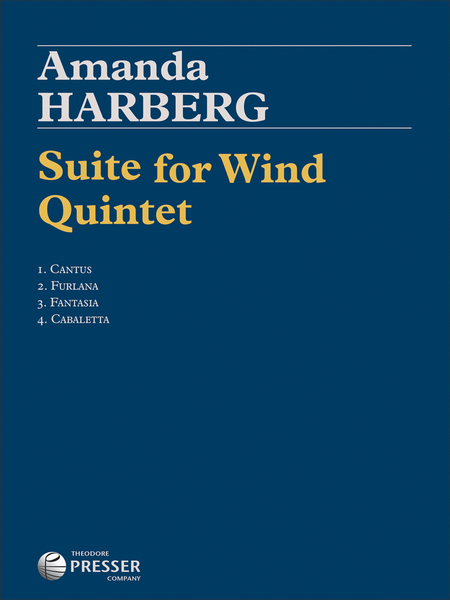Suite for Wind Quintet
-
Ships in 1 to 2 weeks
Details
Description
SKU: PR.114419490
Composed by Amanda Harberg. Folio. Set of Score and Parts. 40+16+16+16+12+12 pages. Duration 18 minutes. Theodore Presser Company #114-41949. Published by Theodore Presser Company (PR.114419490).ISBN 9781491131435. UPC: 680160677320. 9 x 12 inches.
The depth and inventiveness of Amanda Harberg’s SUITE FOR WIND QUINTET can only be described as remarkable. Harberg combines the rich tradition of renaissance and baroque dance suites with her own American voice, stirring up dramatic, exciting sounds and stories. Cantus uses the imitative entries of renaissance motets as a jumping off point into a more contemporary world. The playfully virtuosic Furlana refers to the Italian folk dance rhythm in 6, punctuated by lots of unexpected 5’s. Fantasia hints at being a lullaby with an animated and jazz-influenced middle section, and the closing Cabaletta is true to its 19th-century meaning of a rousing closing section following beautiful lyricism. SUITE FOR WIND QUINTET was commissioned and premiered by the Dorian Wind Quintet.
Amanda Harberg’s Suite for Wind Quintet was commissioned by the Dorian Wind Quintet in 2017. The piece was the result of a conversation in a bar between Harberg, Dorian’s flutist Gretchen Pusch and Pusch’s husband Richard Bayles, on the occasion of Dorian’s clarinetist Ben Fingland’s 40th birthday party. A year and a half later, the Dorian Wind Quintet gave the world premiere of Harberg’s quintet at Bargemusic, and has incorporated it into their repertoire ever since. Suite for Wind Quintet is in four movements- 1. Cantus, 2. Furlana, 3. Fantasia and 4. Cabaletta. The melodic material heard in the very opening of the piece can be heard recurring and transforming throughout the four movements, until it unites triumphantly in the final coda with the theme of the concluding movement. The piece was inspired by the concept of placing Renaissance and Baroque-inspired dance suites into Harberg’s idiom as a 21st century composer.

 Share
Share